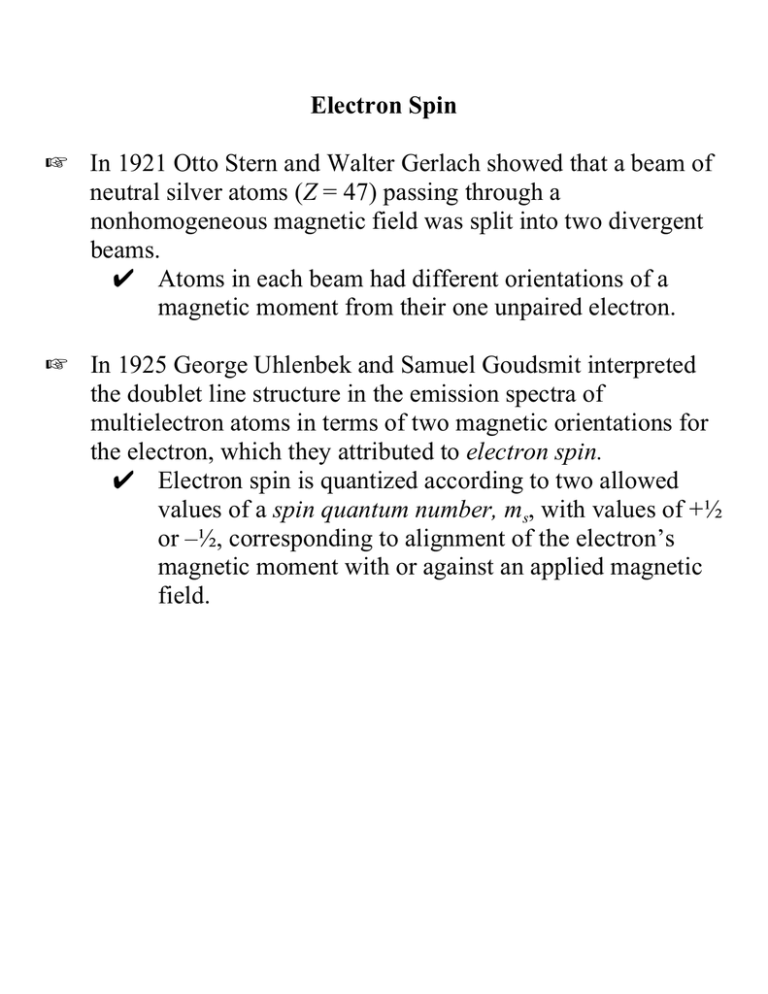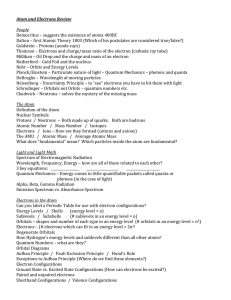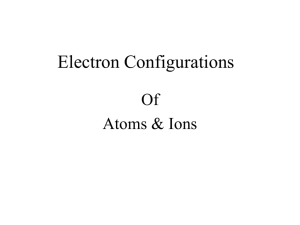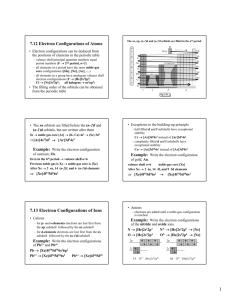Electron Spin L Z
advertisement

Electron Spin L In 1921 Otto Stern and Walter Gerlach showed that a beam of neutral silver atoms (Z = 47) passing through a nonhomogeneous magnetic field was split into two divergent beams. U Atoms in each beam had different orientations of a magnetic moment from their one unpaired electron. L In 1925 George Uhlenbek and Samuel Goudsmit interpreted the doublet line structure in the emission spectra of multielectron atoms in terms of two magnetic orientations for the electron, which they attributed to electron spin. U Electron spin is quantized according to two allowed values of a spin quantum number, ms, with values of +½ or –½, corresponding to alignment of the electron’s magnetic moment with or against an applied magnetic field. Model of Quantized Electron Spin ms = +1/2 ms = -1/2 H L The electron acts as if it were spinning on its axis, where opposite spin directions would create opposite magnetic moments. U In light of wave-particle duality the picture of a spinning electron should not be taken too literally. L When two electrons form a pair within the same atom they align their spins in opposition, causing net cancellation of their oppositely oriented magnetic moments. ¼¿ Ms = +½ – ½ = 0 Electronic Configurations of Multielectron Atoms L The arrangement or configuration of electrons in various orbitals gives rise to a total energy state for the atom. • There are many possible electronic configurations, so there are many possible corresponding energy states. L The lowest possible overall energy state for an atom is its ground state. • The configuration of electrons in specific orbitals that gives rise to this lowest energy state is called the ground state configuration. • Any other configuration will result in a higher energy state, called an excited state for the atom. The Aufbau Concept aufbauen (Ger.) = to build up L The ground state configuration of an atom can be predicted by a bookkeeping process in which electrons are added sequentially to orbitals in the order of their increasing energy. ( The predicted configurations are always correct for the main-group elements (A groups) and are usually correct (with some notable exceptions) for the first transition series elements (period 4). ; Predictions are often slightly or seriously wrong for 5th and 6th period transition elements and the elements of both the lanthanide and actinide series. Orbital Energies in Multielectron Atoms L Orbital energies depend upon both n and l, not just n as in the one-electron atoms. L Within the same shell (same n), subshells vary in energy in the order ns < np < nd < nf L The relative ordering of subshells from different shells varies in a complicated way with changing nuclear charge, Z. Variation in Subshell Ordering He (Z = 2) vs. Mn (Z = 25) He Mn 4s 3d 3p 3d 3s 4s 3p 2p 3s 2s 2p 1s 2s 1s Effective Nuclear Charge L Variation in the subshell energies and relative ordering result from the amount of the nuclear charge experienced by each electron in a multielectron atom. O The portion of the nuclear charge that an electron experiences, called the effective nuclear charge, Z*, is less than the full nuclear charge, Z, because of other electrons between it and the nucleus, expressed by Z* = Z - S where S is the reduction in the charge experienced by the outermost electrons due to the screening or shielding by lower-lying electrons. Screening L The degree of screening depends upon both the shell and subshell of the electron of interest. O Electrons with higher n value are further away from the nucleus and are more highly screened from the nuclear charge by lower lying electrons. K Z* decreases with increasing n. O Within the same shell (same n value), subshells with higher value of l are more extensive and lie further from the nucleus. K Z* decreases with increasing l within the same shell. O The effectiveness of lower-lying subshells in screening declines in the order s > p > d > f. Examples: Z* declines in the order 1s > 2s > 3s > 4s. Subshell energies increase in the order 1s < 2s < 3s < 4s. Z* declines in the order 4s > 4p > 4d > 4f. Subshell energies increase in the order 4s < 4p < 4d < 4f . Aufbau Order of Atomic Orbitals For the purposes of applying aufbau principles to predict ground-state electronic configurations, we only need to know the relative energy order of the subshells when electrons occupy them in the ground-state configuration. ( The Aufbau Order of Subshells 7p 6d 5f 7s 6p 5d 4f 6s 5p 4d 4p 3d 3p 3s 2p 2s 1s 4s 5s Mnemonic for the Aufbau Order 1s 2s 2p 3s 3p 3d 4s 4p 4d 4f 5s 5p 5d 5f 6s 6p 6d 7s 7p 8s Pauli Exclusion Principle Wolfgang Pauli - 1925 No two electrons in the same atom can have the same set of all four quantum numbers (n, l, ml, ms). Consequences: 1. If n, l, and ml are the same for two electrons, then one must have ms = +½ and the other must have ms = -½. The two electrons are said to be paired in the same orbital. Paired electrons: ¼¿ 2. Each orbital can have only two electrons, and the capacities of subshells are thus two times the number of orbitals comprising them. Maximum capacities: s 2, p 6, d 10, f 14 Hund's Rule of Maximum Multiplicity Frederic Hund - 1925 Electrons in the same subshell will tend to distribute so that they are in different degenerate (same energy) orbitals with their spins parallel (same value of ms), so long as the Pauli Exclusion Principle allows. Consequences: 1. Electrons occupy different degenerate orbitals when possible, because this minimizes electron-electron repulsions. not ¼¿ ¼ ¼ 2. Electrons avoid pairing when possible, because it requires energy to pair (pairing energy). 3. Electrons must pair when a subshell is more than half filled (Pauli Exclusion Principle). not ¼¼ ¼ ¼ ¼¿ ¼ ¼ L Hund’s rule applies to the ground-state configuration of an atom, not to its excited states. Exchange Energy L Configurations in which a subshell is half- or fully-filled have extra stability. ¼ ¼ ¼ ¼ ¼ half-filled 3d ¼¿ ¼¿ ¼¿ ¼¿ ¼¿ fully-filled 3d T These configurations result in a symmetrical distribution of electronic charge, which minimizes repulsions. T The slight energy advantage of these configurations is called exchange energy. T Exchange energy becomes more significant with greater orbital multiplicity (more orbitals per subshell); i.e., s<p<d<f K Exchange energy sometimes results in groundstate configurations that deviate from the aufbau predictions. Electronic Configurations for the First Ten Elements Element 1s 2s 2p Spectroscopic Notation H ¼ 1s1 He ¼¿ 1s2 Li ¼¿ ¼ 1s22s1 Be ¼¿ ¼¿ 1s22s2 B ¼¿ ¼¿ ¼ 1s22s22p1 C ¼¿ ¼¿ ¼ ¼ 1s22s22p2 N ¼¿ ¼¿ ¼ ¼ ¼ 1s22s22p3 O ¼¿ ¼¿ ¼¿ ¼ ¼ 1s22s22p4 F ¼¿ ¼¿ ¼¿ ¼¿ ¼ 1s22s22p5 Ne ¼¿ ¼¿ ¼¿ ¼¿ ¼¿ 1s22s22p6 Third Period Configurations 1A 8A 1 H 2A 3A 4A 5A 6A 7A He 2 Li Be B C N O F Ne 3 Na Mg Al Si P S Cl Ar Na 12Mg 13Al 14Si 15P 16S 17Cl 18Ar 11 1s22s22p63s1 1s22s22p63s2 1s22s22p63s23p1 1s22s22p63s23p2 1s22s22p63s23p3 1s22s22p63s23p4 1s22s22p63s23p5 1s22s22p63s23p6 Fourth Period Configurations 1A 8A 1 H 2A 3A 4A 5A 6A 7A He 2 Li Be B C N O F Ne 3 Na Mg 3B 4B 5B 6B 7B +) 8B ), 1B 2B Al Si P S Cl Ar 4 K Ca Sc Ti V Cr Mn Fe Co Ni Cu Zn Ga Ge As Se Br Kr K 1s22s22p63s23p64s1 1s22s22p63s23p64s2 20Ca 19 21Sc 22Ti 23V 24Cr 25Mn 26Fe 27Co 28Ni 29Cu 30Zn 1s22s22p63s23p63d14s2 1s22s22p63s23p63d24s2 1s22s22p63s23p63d34s2 1s22s22p63s23p63d54s1 ¶Irregular 1s22s22p63s23p63d54s2 1s22s22p63s23p63d64s2 1s22s22p63s23p63d74s2 1s22s22p63s23p63d84s2 1s22s22p63s23p63d104s1 ¶ Irregular 1s22s22p63s23p63d104s2 Ga 32Ge 33As 34Se 35Br 36Kr 1s22s22p63s23p63d104s24p1 1s22s22p63s23p63d104s24p2 1s22s22p63s23p63d104s24p3 1s22s22p63s23p63d104s24p4 1s22s22p63s23p63d104s24p5 1s22s22p63s23p63d104s24p6 31 Fifth Period Configurations 1A 2A 3B 4B 5B 6B 7B +) 8B ), 1B 2B 3A 4A 5A 6A 7A 8A 4 K Ca Sc Ti V Cr Mn Fe Co Ni Cu Zn Ga Ge As Se Br Kr 5 Rb Sr Y Zr Nb Mo Tc Ru Rh Pd Ag Cd In Sn Sb Te I Xe Rb [Kr]5s1 [Kr]5s2 38Sr 37 Y 40Zr 41Nb 42Mo 43Tc 44Ru 45Rh 46Pd 47Ag 48Cd [Kr]4d15s2 [Kr]4d25s2 [Kr]4d45s1 [Kr]4d55s1 [Kr]4d65s1 [Kr]4d75s1 [Kr]4d85s1 [Kr]4d105s0 [Kr]4d105s1 [Kr]4d105s2 In 50Sn 51Sb 52Te 53I 54Xe [Kr]4d105s25p1 [Kr]4d105s25p2 [Kr]4d105s25p3 [Kr]4d105s25p4 [Kr]4d105s25p5 [Kr]4d105s25p6 39 49 ¶ No easy explanation ¶ Like Cr ¶ No easy explanation ¶ No easy explanation ¶ No easy explanation ¶ Fully-filled 4d ¶ Like Cu Configurations in the Sixth Period 6 1A 2A 3B 4B 5B 6B 7B +) 8B Cs Ba La Hf Ta W Re Os Ir Ce Pr Nd Pm Sm Eu 1B 2B 3A 4A 5A 6A 7A 8A Pt Au Hg Tl Pb Bi Po At Rn Gd Tb Dy Ho Er Tm Yb Lu ), Cs [Xe]6s1 [Xe]6s2 56Ba 55 57La [Xe]5d16s2 Ce 59Pr 60Nd 61Pm 62Sm 63Eu 64Gd 65Tb 66Dy 67Ho 68Er 69Tm 70Yb 71Lu [Xe]4f 15d16s2 [Xe]4f 36s2 [Xe]4f 46s2 [Xe]4f 56s2 [Xe]4f 66s2 [Xe]4f 76s2 [Xe]4f 75d16s2 [Xe]4f 96s2 [Xe]4f 106s2 [Xe]4f 116s2 [Xe]4f 126s2 [Xe]4f 136s2 [Xe]4f 146s2 [Xe]4f 145d16s2 58 72Hf 73Ta 74W 75Re 76Os 77Ir 78Pt 79Au 80Hg [Xe]4f 145d26s2 [Xe]4f 145d36s2 [Xe]4f 145d46s2 [Xe]4f 145d56s2 [Xe]4f 145d66s2 [Xe]4f 145d76s2 [Xe]4f 145d96s1 [Xe]4f 145d106s1 [Xe]4f 145d106s2 Tl 82Pb 83Bi 84Po 85At 86Rn [Xe]4f 145d106s26p1 [Xe]4f 145d106s26p2 [Xe]4f 145d106s26p3 [Xe]4f 145d106s26p4 [Xe]4f 145d106s26p5 [Xe]4f 145d106s26p6 81 Configurations in the Seventh Period 7 1A 2A 4B 5B 6B 7B +) 8B ), Fr Ra Ac Rf Db Sg Bh Hs Mt Th Pa U Np Pu Am Fr [Rn]7s1 [Rn]7s2 88Ra 1 2 Ac [Rn]6d 7s 89 87 Th 91Pa 92U 93Np 94Pu 95Am 96Cm 97Bk 98Cf 99Es 100Fm 101Md 102No 103Lr 90 [Rn]6d27s2 [Rn]5f 26d17s2 [Rn]5f 36d17s2 [Rn]5f 46d17s2 [Rn]5f 67s2 [Rn]5f 77s2 [Rn]5f 76d17s2 [Rn]5f 97s2 [Rn]5f 107s2 [Rn]5f 117s2 [Rn]5f 127s2 [Rn]5f 137s2 [Rn]5f 147s2 [Rn]5f 146d17s2 Cm Bk Cf Es Fm Md Predicted Aufbau configurations 14 2 2 Rf [Rn]5f 6d 7s 104 14 3 2 105Db [Rn]5f 6d 7s 14 4 2 106Sg [Rn]5f 6d 7s 14 5 2 107Bh [Rn]5f 6d 7s 14 6 2 Hs [Rn]5f 6d 7s 108 14 7 2 109Mt [Rn]5f 6d 7s [110] [Rn]5f 146d87s2 [111] [Rn]5f 146d97s2 [112] [Rn]5f 146d107s2 No Lr Valence Configurations L The outermost electrons in an atom constitute the valence configuration. • Electrons are gained, lost, and shared from the subshells of the valence configuration in forming chemical bonds. • Elements have characteristic valence configurations based on their positions in the periodic table. Periodic Table Showing Subshells Being Filled representative elements representative elements transition elements lanthanides and actinides 1A 1 8A 2A 3A 2 3 4 5 6 7 3B 4B 5B 6B 7B +)) 8B )), 1B 2B 4A 5A 6A 7A Valence Configurations by Periodic Table Position Block Type Valence Configuration ns x (x = 1, 2) ns2np x (x = 1 - 6) (n-1)d xns y (x = 1 - 10; y = 0 - 2) (n-2)f xns y (x = 1 - 14; y = 0 - 2) Periodic Table for Practice in Predicting Valence Configurations by Position 1A 8A 1 H 2A 3A 4A 5A 6A 7A He 2 Li Be B C N O F Ne 3 Na Mg 3B 4B 5B 6B 7B +) 8B ), 1B 2B Al Si P S Cl Ar 4 K Ca Sc Ti V Cr Mn Fe Co Ni Cu Zn Ga Ge As Se Br Kr 5 Rb Sr Y Zr Nb Mo Tc Ru Rh Pd Ag Cd In Sn Sb Te I Xe 6 Cs Ba La Hf Ta W Re Os Ir Pt Au Hg Tl Pb Bi Po At Rn 7 Fr Ra Ac Rf Ha Sg Ns Hs Mt Ce Pr Nd Pm Sm Eu Gd Tb Dy Ho Er Tm Yb Lu Th Pa U Np Pu Am Cm Bk Cf Es Fm Md No Lr





